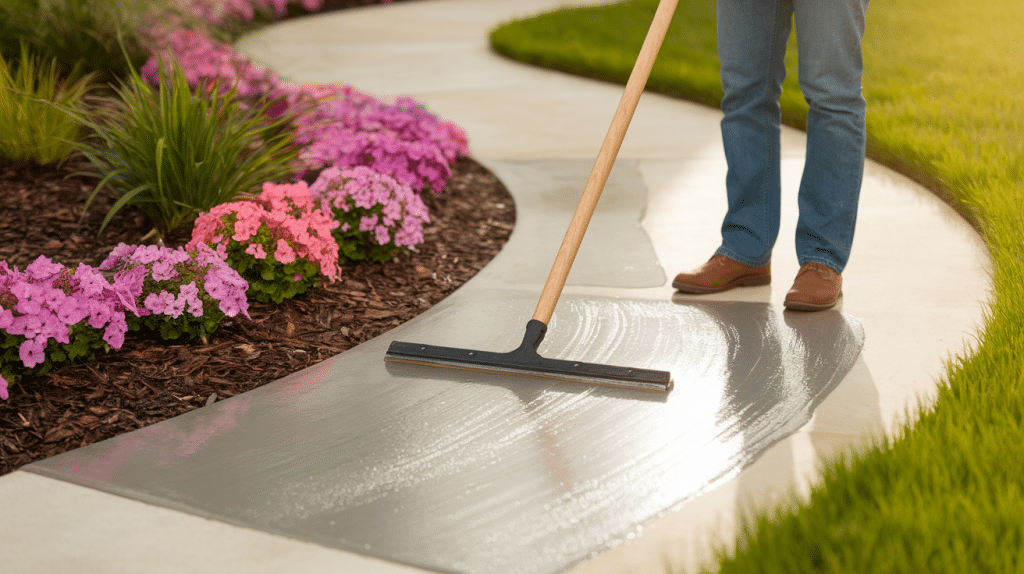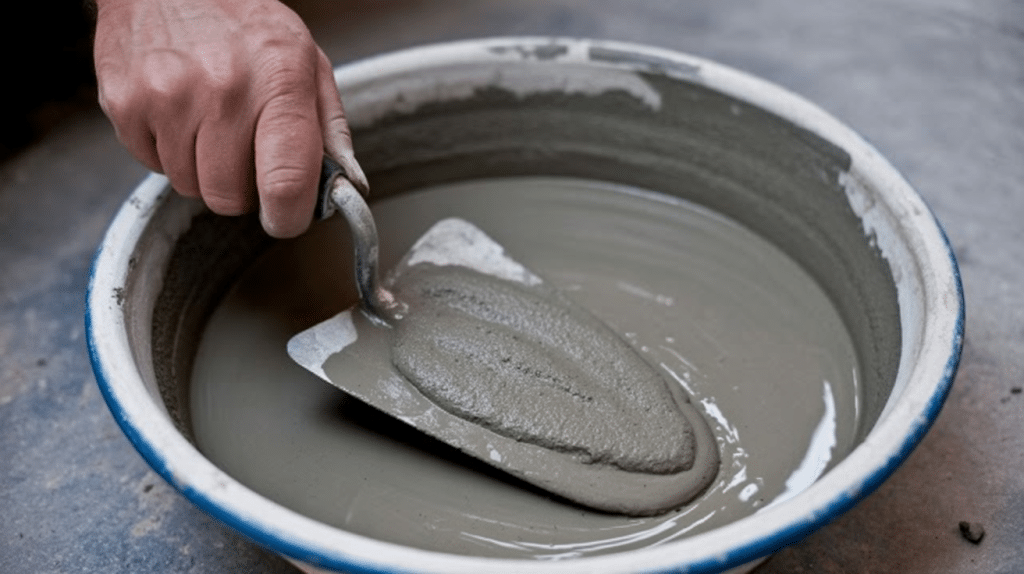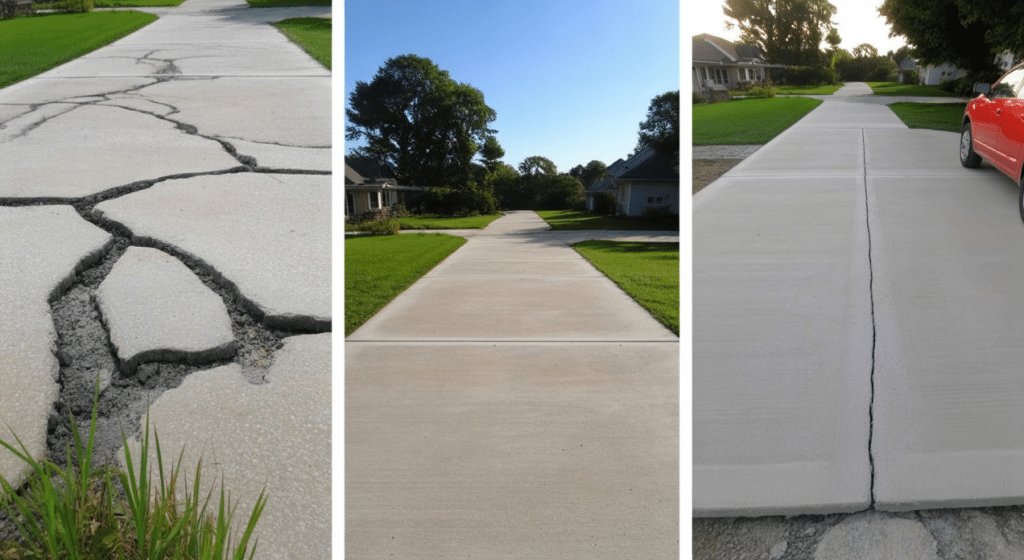Cracked, stained, or worn concrete surfaces don’t have to be permanent eyesores or safety hazards in your home.
Many homeowners facing deteriorating driveways, patios, or garage floors wonder: Can you resurface concrete instead of replacing it entirely?
The answer is yes – concrete resurfacing offers a cost-effective solution that can modify tired surfaces into attractive, functional areas.
This process involves applying a thin layer of new concrete material over your existing Surface, similar to giving your concrete a fresh new skin.
But here’s what you want to know: how long will this solution last?
Properly resurfaced concrete typically lasts 8-15 years with good maintenance, making it a wise investment for most homeowners.
What is Concrete Resurfacing and Why Is It Done?
Concrete resurfacing means applying a thin layer of new concrete material over your existing Surface.
Think of it like putting a fresh coat of paint on a wall, but instead of paint, you’re using a special concrete mixture that bonds to the old Surface.
Why Choose Resurfacing Over Replacement?
| Pros of Resurfacing | Cons of Resurfacing |
|---|---|
| Costs 50-75% less than replacement | Won’t fix major structural problems |
| Takes 1-2 days instead of weeks | Limited to surfaces in decent condition |
| No need to remove old concrete | May need redoing in 8-15 years |
| Improves appearance and function | Adds height to the existing Surface |
| Can add decorative finishes | Requires proper surface preparation |
When Should You Consider Resurfacing?
Your concrete is a good candidate for resurfacing if it has surface-level issues, such as small cracks, stains, or wear, but remains structurally sound.
Look for signs like minor cracking (less than 1/4 inch wide), surface pitting, discoloration, or a rough, worn texture.
However, if you have major cracks, settling issues, or deep structural damage, replacement might be your better option.
How Long Does Resurfaced Concrete Last?

The typical lifespan of resurfaced concrete ranges from 8 to 15 years, but this varies significantly based on several key factors.
Factors That Affect How Long It Lasts
Climate and Weather: Extreme temperature changes, freeze-thaw cycles, and heavy precipitation can shorten the lifespan. Areas with mild climates typically see longer-lasting results.
Traffic and Usage: A residential walkway will last longer than a busy driveway or commercial area. Heavy vehicles, frequent foot traffic, and industrial use all contribute to reduced longevity.
Quality of Materials: Premium resurfacing products cost more but typically last longer than budget options. The thickness of the application also matters – thicker applications generally last longer.
Maintenance Level: Regular cleaning, prompt repair of minor issues, and periodic sealing can significantly extend the life.
Signs You May Need to Resurface Again:
- Cracks appearing in the resurfaced layer
- Peeling or flaking of the surface material
- Stains that won’t clean off
- Rough or uneven texture returning
- Water is pooling instead of draining properly
Project Preparation: Getting Ready for Resurfacing
Success starts with proper preparation. Rushing this step is the biggest mistake people make.
Cleaning the Surface Thoroughly
- Remove all dirt, oil stains, paint, and debris using a pressure washer with degreasing detergent.
- Apply concrete degreaser to stubborn oil stains and scrub with a stiff brush for complete cleaning.
Checking for Damage That Needs Attention
- Walk around and mark all cracks, holes, and damaged areas with chalk for easy identification.n
- Measure crack widths – anything over 1/4 inch needs exceptional repair before resurfacing.ng
Gathering Your Tools and Materials
- Basic tools: mixing buckets, drill with paddle, squeegee or trowel, texturing brush
- Materials needed: concrete resurfacer, crack filler, degreaser, clean water, safety gear
Fixing Damaged Areas Before Resurfacing
Proper repairs ensure your resurfacing job lasts as long as possible.
| Damage Type | Repair Method | Materials Needed | Key Steps |
|---|---|---|---|
| Small Cracks & Holes (up to 1/4 inch) | Crack filler application | Concrete crack filler is in a squeeze tube, a wire brush, and a vacuum | Clean out debris with a wire brush or vacuum. Apply filler deep into the crack. Smooth level with the surrounding concrete. Let cure per package directions. |
| Large Cracks & Pitting (over 1/4 inch) | Patching compound repair | Concrete patching compound, trowel, mixing tools | Mix the compound per directions. Apply with a trowel, slightly overfilling the area. Scrape level when it starts to set. Allow full curing time before resurfacing. |
| Material Selection | Choose proper products | Concrete-specific repair materials | Use products designed for concrete repair, not general fillers. Look for good bonding properties and similar expansion rates. Select materials that are compatible with your resurfacing system. |
Mixing and Applying the Resurfacer

Getting the mixture right and applying it correctly makes a huge difference in how long your project lasts.
1. Mixing the Resurfacer Correctly
Follow the package directions exactly; don’t guess at measurements. Most resurfacers mix with just water, but the ratio is critical.
Mix only what you can use in about 20 minutes, as the material starts to set quickly.
Use a drill with a mixing paddle for optimal results, and ensure there are no lumps.
2. Application Techniques That Work
Start at one end and work systematically across the Surface. Pour the mixed resurfacer onto the concrete and spread it with a squeegee or long-handled brush.
Work in sections small enough to complete before the material starts to set. Maintain a consistent thickness, typically around 1/8 to 1/4 inch.
3. Smart with Timing
Plan your work for mild weather; avoid very hot, cold, or windy days. Early morning often provides the best conditions. Have all your tools ready and work with a helper if possible.
Once you start applying, you need to keep moving steadily.
Curing and Maintaining Your Resurfaced Concrete
How you care for the concrete in the first few weeks and on an ongoing basis determines how long it lasts.
1. The Curing Process
Keep the resurfaced area damp for at least 24 hours by misting with water or covering with plastic sheeting.
Avoid walking on it for at least 24 hours and keep vehicles off for 48 to 72 hours. Full strength develops over about 28 days, so be gentle during this period.
2. Regular Maintenance Tips
Clean spills promptly to prevent staining. Sweep regularly to remove dirt and debris that can act like sandpaper, as they can damage surfaces over time.
Apply a concrete sealer every 2-3 years to protect against moisture and stains. Address small cracks promptly before they escalate into larger issues.
3. Protecting Your Investment
Avoid using ice melt chemicals in winter, as these can damage the Surface. Place mats under vehicles that might leak oil.
Consider adding expansion joints if resurfacing large areas to prevent cracking from temperature changes.
Common Mistakes That Shorten Lifespan

Learning from others’ mistakes can save you time and money.
- Poor Surface Preparation: Failing to perform proper cleaning or crack repairs results in poor bonding and premature failure. Remember: “clean twice, resurface once.”
- Incorrect Mixing: Adding too much or too little water can affect the strength and durability of the product. Follow package directions exactly and use measuring marks for consistency.
- Rushing the Curing Process: Using the Surface too soon or inadequate moisture during curing reduces strength and lifespan. Plan for 2-3 days out of service.
With proper preparation, application, and maintenance, expect your resurfaced concrete to last 8-15 years or longer. Key factors include original concrete condition, material quality, application technique, and ongoing maintenance.
Well-maintained, resurfaced concrete in ideal conditions can last over 15 years, while poor preparation may cause wear within 8 years.
When Can You Resurface Concrete vs. When to Replace
Sometimes resurfacing isn’t the answer. Consider complete replacement if you have major structural cracks, significant settling or heaving, or if the concrete has already been resurfaced multiple times.
Deep foundation problems or severe damage across large areas also point toward replacement rather than another resurfacing job.
Making Your Resurfaced Concrete Last
Can you resurface concrete? Absolutely, and it’s a wise investment for homeowners with surface-level damage.
Success depends on thorough surface preparation, quality materials, correct application techniques, and ongoing care.
While climate, usage patterns, and maintenance affect longevity, properly resurfaced concrete can significantly extend the life of your surface.
If tackling driveways, patios, or garage floors, resurfacing offers an affordable solution that modifies worn concrete into attractive, functional surfaces.
Start your concrete resurfacing project today and give your surfaces a fresh new life that lasts for years to come.


